Oct 28 2020
According to geo-ecologist Julie Aleman, a visiting scientist in the department of geography at the Université de Montréal (UdeM), the state of mature ecosystems must be considered before huge reforestation plans can be implemented in sub-Saharan Africa.
 The impact of human activity can be seen wherever the researchers carried out their research, but mainly in Tanzania, Congo, and the Central African Republic. Image Credit: GETTY.
The impact of human activity can be seen wherever the researchers carried out their research, but mainly in Tanzania, Congo, and the Central African Republic. Image Credit: GETTY.
The biomes of the region we studied, which includes all the countries south of the Sahara, are divided into two fairly distinct types: savannah at about 70 percent and tropical forest for the rest.
Julie Aleman, Study Co-Author, Department of Geography, Université de Montréal
The major new study is aimed at African biomes and involves around 30 scientists, many from Africa itself. This study was published recently in the Proceedings of the National Academy of Science.
When we analyze the assemblage of tree species in each biome, we find that each is extremely different. Moreover, if we look closely at the history of these biomes, we realize that they have been fairly stable for 2,000 years. Reforestation with tropical forest species in areas that are more associated with savannahs would therefore be a mistake.
Julie Aleman, Study Co-Author, Department of Geography, Université de Montréal
Without naming countries that might make this error, Aleman highlighted that reforestation plans involved the planting of billions of trees. The intention may be good, but countries should avoid artificially developing tropical forests where savannahs have ruled for many millennia, she added.
Furthermore, the kind of species selected is pivotal. Acacias are more related to open environments, for instance, while Celtis trees are meant for forests. In certain cases, eucalyptus plantations have turned out to be “ecological disasters,” according to Aleman.
Tracing the Past
Aleman does her research at UdeM’s paleoecology laboratory, whose vision under director Olivier Barquez is to retrace the history behind biomes. Adeline Fayolle, Aleman’s chief collaborator and a professor at the University of Liege, in Belgium, collected the floristic data (lists of tree species) needed for this study.
To do this, we conducted a kind of old-fashioned data mining, in the sense that we analyzed a large amount of existing data, published and sometimes archived in forgotten documents, buried in dust, as well as data recently acquired in the field, to try to understand the history of the region.
Julie Aleman, Study Co-Author, Department of Geography, Université de Montréal
The research considers environmental, floristic, and paleoecological data equally to gain better insights into the ecological working of savannas and forests, helped by examining 753 sites in both settings. The environmental parameters with the maximum impact on these settings are rainfall and its seasonality, apart from temperature, the team learned.
In the savannah, one of the most extraordinary occurrences is the frequency of disturbances that impact them. For instance, in certain areas, brushwoods tend to flare at least three times annually. To safeguard public health, local governments occasionally intend to restrict these fires. These steps are legitimate but can have major ecological impacts, added the researchers.
The reason is large trees are mostly not impacted by the flames, and the ashes renew the soil.
Almost Devoid of Wildlife
The effect of human activity can be witnessed wherever the team did their study, but predominantly in Congo, Tanzania, and the Central African Republic. In certain cases, a few areas are virtually devoid of wildlife.
From 2017, when Aleman published a paper in the African issue of the online forum “The Conversation,” she has been making steady efforts to alert public opinion to the dangers to African ecosystems.
She trusts that the issue is not desperate but that governments have to be cautious in how they intervene so that they do not mess things further. Aleman anticipates that the new study will result in improved insights into the biological truth of the African continent.
“This is a rather theoretical contribution,” she said, “but I believe that we can use it to inform reforestation policies.”
Journal Reference:
Aleman, J. C., et al. (2020) Floristic evidence for alternative biome states in tropical Africa. Proceedings of the National Academy of Sciences. doi.org/10.1073/pnas.2011515117.